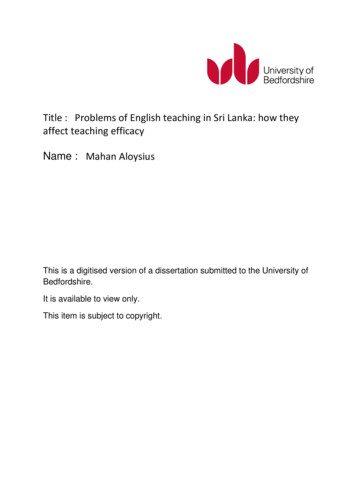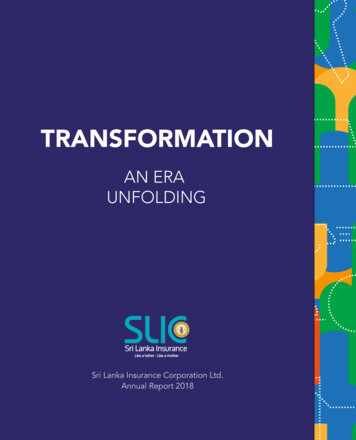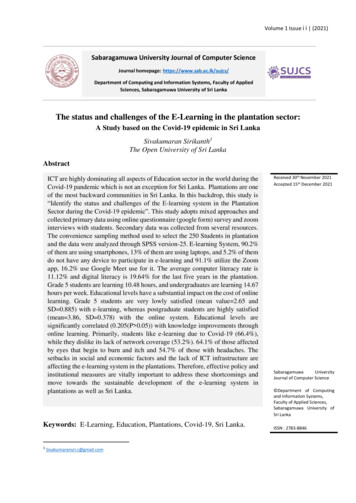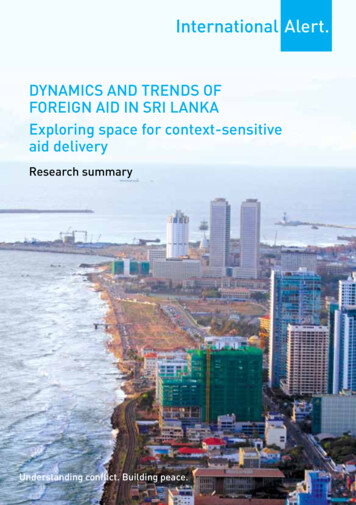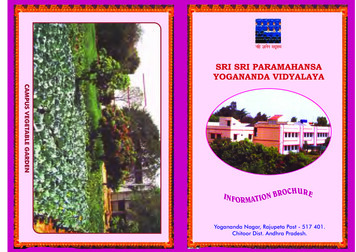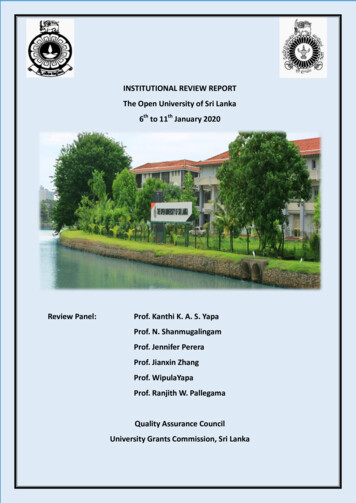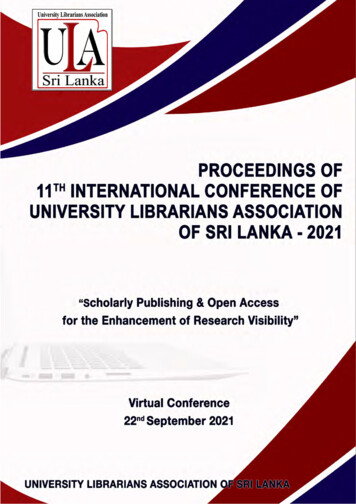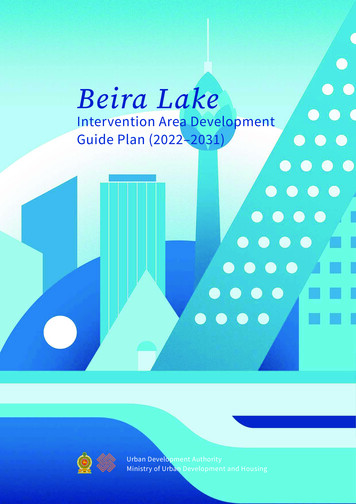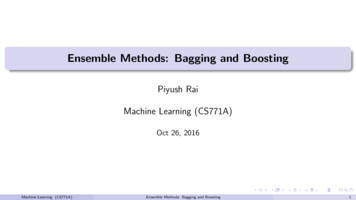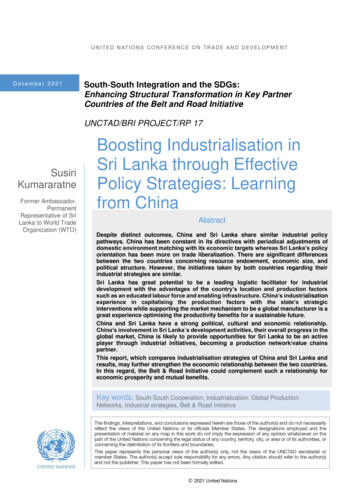
Transcription
December 2021South‐South Integration and the SDGs:Enhancing Structural Transformation in Key PartnerCountries of the Belt and Road InitiativeUNCTAD/BRI PROJECT/RP 17SusiriKumararatneFormer Ambassador,PermanentRepresentative of SriLanka to World TradeOrganization (WTO)Boosting Industrialisation inSri Lanka through EffectivePolicy Strategies: Learningfrom ChinaAbstractDespite distinct outcomes, China and Sri Lanka share similar industrial policypathways. China has been constant in its directives with periodical adjustments ofdomestic environment matching with its economic targets whereas Sri Lanka’s policyorientation has been more on trade liberalisation. There are significant differencesbetween the two countries concerning resource endowment, economic size, andpolitical structure. However, the initiatives taken by both countries regarding theirindustrial strategies are similar.Sri Lanka has great potential to be a leading logistic facilitator for industrialdevelopment with the advantages of the country’s location and production factorssuch as an educated labour force and enabling infrastructure. China’s industrialisationexperience in capitalising the production factors with the state’s strategicinterventions while supporting the market mechanism to be a global manufacturer is agreat experience optimising the productivity benefits for a sustainable future.China and Sri Lanka have a strong political, cultural and economic relationship.China’s involvement in Sri Lanka s development activities, their overall progress in theglobal market, China is likely to provide opportunities for Sri Lanka to be an activeplayer through industrial initiatives, becoming a production network/value chainspartner.This report, which compares industrialisation strategies of China and Sri Lanka andresults, may further strengthen the economic relationship between the two countries.In this regard, the Belt & Road Initiative could complement such a relationship foreconomic prosperity and mutual benefits.Key words: South-South Cooperation, Industrialization, Global ProductionNetworks, Industrial strategies, Belt & Road Initiative 2021 United Nations
2ECIDC PROJECT PAPER No.17ContentsAcknowledgements . 31.South-South Cooperation . 42.Sri Lanka industrialisation and industrial policy development . 53.Challenges experienced during Sri Lanka’s industrialisation . 133.1.Policy consistency . 133.2.Debt burden . 133.3.Infrastructure development . 143.4.Industry concentration . 143.5.Lack of diversification . 143.6.Productivity improvement . 143.7.Exploring Global Manufacturing Value Chain (GMVC) . 153.8.Skills development and Labour market . 153.9.Innovation . 163.10.Cost of Production . 163.11.Digital Economy . 164.The emergence of China’s industrialisation . 174.1.State-owned enterprises (SOEs) . 184.2.Industry Structural Change . 194.3.Global Value Chain/Global Manufacturing Networks . 204.4.Governance in support of industrialisation . 214.5.Financial stability and FDI attraction . 224.6.Administrative & Management Change . 244.7.Market Economy . 254.8.Labour Reforms . 255.Learning from China’s experience towards policy directions . 265.1.State-owned enterprises . 275.2.Industrial structure . 275.3.Global production networks (GPNs) . 285.4.Governance and Industrial Policy . 295.5.Financial Stability and Industrialisation . 305.6.Management Reforms . 315.7.Market Reforms. 315.8.Labour Market . 326.Conclusion . 32Appendix . 33References . 35
3ECIDC PROJECT PAPER No.17AcknowledgementsThis paper has been prepared under the project South-South Integration and The SDGs:Enhancing Structural Transformation in Key Partner Countries of the Belt and Road Initiative,funded by UNPDF Sub-Fund for SDG. The authors are grateful to UNCTAD staff for theircomments and suggestions on the previous versions of this paper. The author also wish tothank Professor Premachandra Athukorala of the Australian National University for hisvaluable guidance and input.
4ECIDC PROJECT PAPER No.171. South-South CooperationIn the past two decades, South-South Cooperation (SSC) has grown dramatically in bothvolume and geographic reach, manifesting itself through various approaches, modalities,and instruments. To a large extent, this growth in cooperation is due to the rise ofdevelopment finance from China and other emerging economies and through moreintensive exchanges between low and middle-income countries. SSC is now widely andexplicitly acknowledged as an important contributor to the Sustainable DevelopmentGoals (SDGs) (Besherati, N A & MacFreely,S, 2019).South-South Cooperation consist of three pillars:(i) Economic Cooperation : Mainly focusing on Trade and Economic development(ii) Technical Assistance : Focusing on technical capacity building through training,exchanges of experts, and sharing of experience and know-how(iii) Knowledge Sharing : The most dynamic dimensions of SSCChina has been playing a significant and proactive role being the leader of the SouthSouth Cooperation. Together with other emerging developing countries, China haspushed South-South trade to outperform both world trade and South-North trade duringthe last decade. South-South trade in goods amounted to about US 5 trillion in 2013,which accounted for about a quarter of world goods trade. In 2000 and 2018, thecountries of the South contributed respectively to 30 and 45 percent of world trade,representing a 50 percent growth during the period. In 2018, China alone accounted for24 percent of exports and 30 percent of imports of all intra-south trade.“Developing countries have significantly increased their participation in GVCs in the lasttwo decades. While in 1995 only about 40 percent of developing countries’ exports wererelated to global value chains, in 2008, 54 percent of developing countries’ exports weretraded within value chains”. (Priyadarshi, 2015). China has been a major player in theGlobal Value Chain (GVC), contributing to the majority of the growth.Intra-south Foreign Direct Investment (FDI) has shown increasing trends, becoming anessential source of trade and economic development for countries in the global South.FDI flows to developing economies reached a record high of US 699 billion in 2018,constituting 47 percent of the world’s FDI flows. In 2018, around 42 percent of globaloutward FDI flows had their origins in developing economies. China has been asignificant source of FDI to many developing countries. Its FDI outflow in 2018 was US 43 billion. China is now believed to be the major source of aid, trade and investment. Inaddition to technical assistance, concessional loans and debt relief, components suchas non-concessional finance, preferential trade agreements, and investment schemesgo well beyond the official development assistance (ODA) definition. Chinese aid is alsovery much integrated with trade and investment.Implementing the WTO Trade Facilitation Agreement and E-Commerce and Globalproduction Networks (GPNs) can further strengthen SSC. With the changing dynamicsof production, consumption, and relationships under the 4th Industrial Revolution (4IR),the SSC will be a critical factor in sustaining the development goals. Artificial intelligence(AI), robotics, the internet of things (IOT), autonomous operations, 3D printing,nanotechnology, biotechnology, cloud computing and electronic data management havestarted playing a more significant role. Therefore, the SSC plays a more crucial role inmaintaining and growing the performance of the South in the future.
5ECIDC PROJECT PAPER No.172. Sri Lanka industrialisation and industrial policydevelopmentIndustrialisation in any country is critical for economic development and socio-economicstructural changes. The industrial sector largely contributes to countries’ economicgrowth, exports, income generation, job creation, poverty reduction, infrastructure andsocio-economic developments. The post-independence transformation of industries inSri Lanka has brought fundamental changes to its structure with mixed results. Althoughit has recorded some remarkable achievements after 1977 reforms, the performancesare yet to be optimized compared to many emerging economies in the region.Establishing an enabling business and policy environment to improve competitivenessand promote diversification and growth is a prerequisite of Industrialisation. Under thepresent global environment, Industrialisation policies need to rely on external markets tosustain long-run stability through possible avenues for joining the global value chains(GVCs).Pre-independence ruling under British colonialism had not concentrated on the abovementioned type of industrial policy. However, it focused on commercial plantations oftea, rubber and coconuts, which brought adequate revenue to the country. With thecountry's independence in 1948, the successive governments until 1977 had mostlyconcentrated on import substitution industries (ISI). The socialist ideology of majorpolitical parties and economic policy trends of many Non-Aligned Countries appeared tohave influenced the domestic policies towards ISI during this period.The reports of the World Bank mission in September 1952 and the Commission ofGovernment Industrial Undertakings (1953) impacted shaping up of the government’sindustrial policy during the 1950s. The World Bank report suggested the development ofnumerous small or medium scale industries rather than a few large ones under stateownership.Since the late 1950s, the changes in the political leadership and growing balance-ofpayments issues persuaded a policy shift toward a state-led import-substitution strategy.In 1955, the government passed the Government Sponsored Corporations Act No. 19 toundertake state-sponsored industries management. This measure was further advancedin 1957 through the State Industrial Corporation Act No. 48, which empowered thegovernment to set up and carry out any industrial undertakings. With a modest start inthe early 1960s, the number of state-owned enterprises (SOEs) multiplied in the first halfof the 1970s.Many institutional initiatives were taken to support this Industrialisation approach, likeestablishing the Ceylon Institute of Scientific and Industrial Research (CISIR) in 1955and, in the same year, the Development Finance Corporation (DFC) to provide long-termcredit needs industrialists.In July 1955, the National Planning Council (NPC) was established under thechairmanship of the Prime Minister Sir John Kotalawala. The country’s first industrialestate, which occupied 32 hectares, was established at Ekala in 1959 under theIndustrial Estate Corporation. The establishment of the People’s Bank in 1961 helped
6ECIDC PROJECT PAPER No.17several small industrialists who found it difficult to obtain loans from other commercialbanks.A bureau of standards was set up in 1968 by the Ministry of Industries to lay downstandards for domestic industrial products to assure the minimum quality standards. InMay 1969, the Industrial Development Board was set up to provide industrial servicefacilities, importation of machinery and raw materials, provision of technical advice,training in basic skills and marketing information and advice, among other services forindustrial sector investors.In 1961 a wide range of incentives was announced to attract private sector and foreigninvestment. These incentives include five-year period exemptions of tax on profits (fullyand partially); 20 percent tax rebates on purchases of plant and machinery and 40percent on approved projects; depreciation allowances; concessionary rates of duties onequipment and raw materials; government’s participation along with private capital in theestablishment of small scale consumer industries; loans to industrial ventures; technicalassistance through Sri Lanka Institute of Scientific and Industrial Research and theDepartment of Small Scale and Cottage Industries; protection of domestic manufacturethrough import controls, tariff adjustment, industrial products (Regulations) Act; andgovernment procurements. (Central Bank of Sri Lanka, 1998)In addition, the following exchange incentives have also been introduced: In 1966, Bonus Voucher Scheme (BVS) was introduced, which providedindustrialists exporting non-traditional goods with import entitlement quotas (IEQ)to the value of 20 percent of the free on board (FOB) value of their exports.The introduction of the Foreign Exchange Entitlement Certificate Scheme(FEECs) in May 1968 provided additional cash incentives to non-traditionalexports through a higher exchange rate.The devaluation of the rupee by 20 percent against the sterling pound in 1967,which encouraged industrial exports, particularly the non-traditional exports.In the 1960s, the policy orientation was based on export promotion under importsubstitution, which had not delivered the expected outcome. The government, in 1970,further strengthened import substitution with greater direct involvement of the state.Heavy protection through tariffs and non-tariff barriers was provided at the expense ofproductivity, competitiveness and private sector participation.“Import restrictions, initially imposed to address payment difficulties, becameincreasingly tight as the development strategy shifted to import-substitution policies andled to pervasive state interventions in the economy. By the mid-1970s, the Sri Lankaneconomy had become one of the most inward-oriented in the world outside theCommunist Bloc.” (Athukorala P C et al., 2017)From 1958 to 1963, during the first phase, there were 14 state-owned large-scaleindustrial corporations. In addition, another 25 more were established by 1974. Closedeconomic policies aimed to develop manufacturing industries behind protective barriershave not delivered the expected results. At the expense of private sector participation,this policy appeared to have slowed down the potential progress of Industrialisation inSri Lanka.The policy on ISI became a failure with a heavy financial burden on the governmentbudget. Like in many developing countries, excess capacity of the industries constrained
7ECIDC PROJECT PAPER No.17by the domestic market and un-competitiveness in the international markets, heavydependence on imported inputs resulting balance of payment (BOP) constraints, lack ofbackward linkage and political motives at the expense of performance have been majorreasons for such failure of SOEs.Since the 1960s, East Asian countries have joined the global manufacturing value chain(GMVC). GMVC operations have been key to the ‘growth miracle’ of East Asia. Sri Lankaappeared to have misdirected its industrial strategy despite possessing much morepromising advantageous production factors than East Asia during the same period.The country appeared to have the essential factors for rapid economic development,elements that were not shared by most other Asian countries: a strategic location in theIndian Ocean, an open economy with a vibrant export sector, a high level of education,an absence of extreme poverty and inequality, a relatively well-developed physicalinfrastructure, and a broad-based and efficient administrative apparatus. (Athukorala, PC et. al., 2017)Lessons learnt by Sri Lanka from East Asian countries' progress have prompted to divertthe country’s strategic approach to industrialisation. Accordingly, a major policy shift hastaken place since 1977, liberalising the trade and removing all control measuresoperative under import substitution.The 1977-79 reforms had profound (largely beneficial) effects on the Sri Lankaneconomy. These reforms (bolstered by the ‘second wave’ in the first half of the 1990s)unshackled the economy from stringent controls. They wrought a remarkabletransformation of the country’s trade and industrial structure. The initial reforms includedphasing out of quantitative import controls, compression and reduction of the import dutystructure, opening up to foreign investment, establishing an efficient free trade zone(FTZ) scheme, freeing of credit markets, institution of a market-responsive unifiedexchange rate, substantial retreat from government ownership and control of productiveenterprises, withdrawal of state trading monopolies, lifting of price controls and thereplacement of the highly subsidised, rice ration system by food stamps targeted tolower-income groups. The early 1990s reforms carried forward impacted trade policies,realigned the exchange rate, freed up exchange control on current transactions, gave amajor impetus to privatisation and strengthened the policy framework for foreign directand portfolio investment. (World Bank, 2004)The 2nd phase of the reforms towards trade liberalisation took place in the late 80s,recognising the dominant role of the private sector. Accordingly, policy decisions weretaken on SOEs privatisation, foreign exchange liberalisation, extended incentives forFDI, rationalisation of import tariffs, and establishing free trade zones, to mention a fewmeasures. Sri Lanka achieved Article VIII status of IMF in 1994 owing to the measuresintroduced on foreign exchange transactions. However, the escalation of the ethnicconflict since the mid-1980s and resulting fiscal pressure have affected the potentialbenefits of the measures.In 1995, at the government's request, the Japan International Cooperation Agency(JICA) and United Nations Industrial Development Organization (UNIDO) undertook amaster plan for industrialisation in Sri Lanka, presented to the Parliament in 2000. Theprime objective of the plan was to move from a labour-intensive industry to knowledgebased technology-driven industrialisation. This ten-year plan identified seven majorindustrial sectors under two broad categories. The plan also defined the 2000-2004period as a consolidation phase and set a growth target of 9.6percent for the existing
8ECIDC PROJECT PAPER No.17industries. The 2005-2010 period was then the period for growth acceleration with anindustry growth target at 10.6 percent.Three industrial sectors, namely apparel, leather and rubber, were selected as globallink industries. The other four industries of electronic sector, plastic products, machinery,and information technology, were identified as policy-driven sectors of the growth plan.Despite daunting efforts of presenting these strategic directives to the Parliament, itappears that these policy suggestions have not moved as planned. There was nosubsequent discussion on the implementation of this master plan.In 2010, the elected President Mahinda Rajapakse presented a policy document titled“Vision for Future”, which emphasised promoting Sri Lanka as the dynamic global hubfor aviation, naval, commercial, energy and knowledge. The open trade policy that hasbeen in place over three decades supported taking forward the concept to become SriLanka a commercial hub in Asia.Table 1 summarises the performances of the industrial sector from 1977 to 2018concerning the gross domestic product (GDP), total exports, and employment.Table 1: Contribution of industries to the national economy, 1977-2018YearGDP inPerBn.US 81248.702799.653843.784080.57Relative Shares of the Industrial sectorFigure 1: Structuralcomponentsof the Indonesian economyUS 6.619.117.527.028.726.226.1Total tpercentage1010.115.024.525.526.027.9Data Source: World Development Indicators (WB) and CBSLThis significant policy change has brought the following major economic benefits to thecountry: Since 1990, continuous GDP and per capita income growth. From 1990 to 2015,Sri Lanka recorded an average GDP growth of over 6 percent. The GDP percapita has increased from US 288 in 1977 to US 4080 in 2018, constituting anupper-middle-income country according to the World Bank’s classification. SriLanka became the first country in the region to record such significant growth.Industrial exports contribution to GDP has substantially increased from 16.6percent in 1977 to 27 percent in 2018.The contribution of manufactured exports showed a continuous increase. It wasat 1.2 percent in 1971 with 10 percent contribution to the total employment,increased up to 78 percent and 28 percent respectively in 2018. The structuralchange to the industries in Sri Lanka after 1977 and the late 1980s hasencouraged moving from traditional land-intensive commercial agriculture-basedproduction of tea, rubber and coconut to labour-intensive manufacturing. Since1960, the share of agriculture has decreased substantially, from about 30 percent
9ECIDC PROJECT PAPER No.17 of GDP to a little over 7 percent in 2018. The industry has expanded from about20 percent of GDP in 1960 to over 27 percent by 2018. The industrial sector'sgrowth with a significant change from traditional to non-traditional exportsdemonstrates the structural change.The share of manufacturing in GDP increased constantly with slight downwardtrends since 2010. The manufacture of apparel products continues to dominate,accounting for the major share of the growth. Apparel products still account foraround 42 percent of total merchandise exports and 69 percent of manufacturedexports (2018). Joining global production networks (GPNs) led by buyers haspaved the way for the success of the apparel industry in Sri Lanka despite theindustry’s high import intensity on inputs at the beginning and gradual decreasein comparative labour cost advantage. Apparel industry progress is discussedseparately in the latter part of the paper.The industrial sector contributed to a significant proportion of employment,bringing unemployment and poverty levels substantially low. The industrialsector, which accounted for less than 10 percent of employment in 1971,increased to 28 percent in 2018. With this development, rapid urbanisation hastaken place in the country.The important observation is that the factor content of Sri Lanka’s exportschanged radically from around 3 percent in labour-intensive manufactures during1962–77 to nearly 60 percent during 1990–95. (Athukorala, PC andRajapathirana, S, 2000)The reform policies of the 1977 and late 1980s have attracted foreign and localinvestments to industries. At the same time, the government has improved theinstitutional capacity to facilitate such investment. In 1978, the Greater ColomboEconomic Commission (GCEC) was established with particular attention todeveloping free trade zones in Sri Lanka. GCEC was subsequently named asBoard of Investment with larger capacity and authority to handle investments inSri Lanka. In order to extend the related services to industries and their exports,new institutions such as Sri Lanka Export Development Board (1979), and SriLanka Export Credit Insurance Corporation (1979) were established.The Sri Lankan experience highlights the complementary role of investment liberalisationfor exploiting the potential gains from trade liberalisation: trade liberalisation increasedthe potential returns to investment by capitalising on the country’s comparativeadvantage. At the same time, liberalisation of foreign investments permitted internationalfirms to take advantage of such profit opportunities.According to the World Bank’s Development Indicators, FDI increased three times from1990 to 2000. Similarly, it was further increased by 176 percent between 2000 and 2010.Sri Lanka foreign direct investment for 2018 was 1.61 billion, a 17.58 percent increasefrom 2017 ( 1.37 billion in 2017), with a rise of 53.03 percent compared to 2016.Although the official aggregate figures show a notable increase in total FDI inflows duringthe past three years, data at the sectoral and industrial level reveal that the growth hascome mainly from construction and tourism-related services. FDI into the industriesremains at a relatively low level.
10ECIDC PROJECT PAPER No.172.1.Structural Changes to the IndustriesFigure 1 illustrates the structural change of the industries in Sri Lanka since 1960. Theliberalisation reforms in 1977 have made significant structural changes to the sectors inSri Lanka. The apparel sector became the single largest industry in terms of exportearnings and employment in the industrial sector. From 1992, apparel has been SriLanka’s single largest export product. Over the years, the composition of manufacturedexports has diversified into other labour and resource-based products. However, apparelstill accounts for over 42 percent of total merchandise exports, over 60 percent ofmanufacturing exports and around 60 percent of industrial sector employment, accordingto 2018 data. (Central Bank of Sri Lanka, 2019)Figure 1: Structural changes in the manufacturing Industries of Sri Lanka (Percent)60Table1: Indonesia: rank on global competitiveness index, 2018 and 20195040302010019601980199620002005201020151 Food Beverages & Tobacco2 Textile, Wearing Apparel & Lather3 Wood & Wood Products4 Paper & Paper Products5 Chemicals, Plastic and Rubber6 Non Metallic Minerals Products7 Basic Metallic Products8 Fabricated Metal Products20189 Products (n.e.s.)Source: Central Bank of Sri LankaThe Multi-Fibre Arrangement (MFA) governed the world trade in textiles and garmentsfrom 1974 through 1994, imposing quotas on the amount developing countries couldexport to developed countries. Its successor, the Agreement on Textiles and Clothing(ATC) under the WTO, expired on 1 January 2005. The performance of Sri Lanka’sapparel industry after the MFA is particularly impressive, especially considering theabsence of preferential market access to the major markets in Europe (until eligible forGSP Plus) and North America and the cost of labour compared to many other apparelproducing countries in the region and Africa.The evolution of the apparel industry has been from contract manufacturing to serviceprovider and a remarkable knowledge-based industry. Vertical value chain integrationwith advanced technology and corporate responsibility brought the industry to a globalplayer level. The “garment without guilt” campaign launched by the Joint ApparelAssociation Forum (JAAF) played a pivotal role in strengthening corporate social
11ECIDC PROJECT PAPER No.17responsibility commitments among apparel exporting firms and promoting Sri Lanka asan ethical clothing manufacturer destination. The impressive record of compliance withethical employment practices and internationally agreed environmental standards haveenhanced Sri Lanka’s attractiveness as a source of procurement for the leading brandmarketers and specialised stores. Moving toward advanced technology and ethicalpractice with commitments to environmental protection have led to the establishment of“green factories” (zero carbon), fair-trade production and application of nanotechnologyand IT.With the industrial expansion, apparel manufacturers advocate Industry 4.0 whilepreparing for the next evolution, industry 5.0, to be truly sustainable future factories. Witha combination of local resources and global technologies, Sri Lanka has been aninnovative manufacturer of novel clothing and fashion solutions in the global market. Thecountry has been producing wearable electronics, e-textiles and smart clothi
(iii) Knowledge Sharing : The most dynamic dimensions of SSC China has been playing a significant and proactive role being the leader of the South-South Cooperation. Together with other emerging developing countries, China has pushed South-South trade to outperform both world trade and South-North trade during the last decade.
